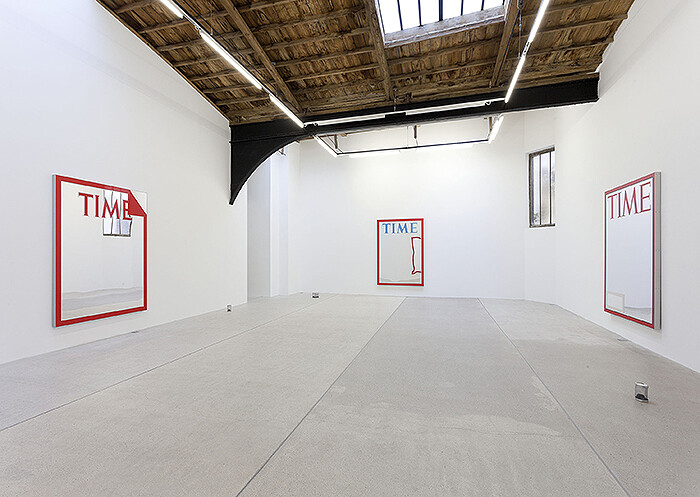In his first exhibition at Galerie frank elbaz, Los Angeles-based artist Mungo Thomson balances tidy conceptualism with dexterous formal conceits in his ongoing, obsessive abstractions of the editorial purview and design of the iconic TIME magazine. Minimally installed, the exhibition is anchored by a room of four wall-mounted mirror works scaled roughly to the size of a tall man, like the artist himself. Styled after the immediately recognizable graphic design of the magazine, each mirror pane is framed by a red line within which the four letters of TIME are printed in a concise array of differing colors and serif fonts.
The typography, which slightly varies from one mirror to the next, directly corresponds to the design used for the magazine issues whose original photographic cover image Thomson has effectively erased in favor of the viewer’s own reflection—March 23, 1987 (The Nature of the Universe), April 16, 1990 (Unlocking the Secrets of the Universe), August 4, 2003 (The Science of Meditation), and October 13, 1975 (Meditation: The Answer to all Your Problems?) (all works 2013). Each of the editions that Thomson selected for the exhibition alludes to metaphysical concepts, the inner mind, or outer space—enduring themes that shape the larger constellation of his practice.
Chance creeps into these pieces by way of other distinguishing features—namely, the imperfections the artist found on the printed copies of the magazine he bought on eBay so that he could recreate the exact typeface for each work. One example still has a mailing label attached to it, while another has a dog-eared corner, revealing an additional reflective triangle that stands in for negative space.
Thomson calls these details painterly flourishes. While they do rest on the surface, the most life to be found in these flat sheets of slow moving liquid is actually produced within them. Thinner than their ordinary counterparts, the mirrors he uses have natural undulations that generate a subtle fun-house effect. However, instead of creating the illusion of infinite hallways, the arrangement of the four mirror works are offset from one another, hung as paintings rather than as components of an optically driven installation. But as a virtue of basic geometry, there are sweet spots in the room where you can catch the image of three or even all four works within a single frame. Peering through the concentric gates of the magazine conjures the semblance of the wobbly waters of time, and the view becomes increasingly unstable the further back you go. Similarly, the reflections of viewers passing through the gallery phase back and forth from looking like real people to unfurling like genies. And when time stands still, this instability will persist after the closing of the exhibition in the photographic documentation of the installation.
Another thing in the room, soon to be an elephant, is a heap of mail accumulating at the door. The gallery has agreed, per Thomson’s instructions, not to open any mail throughout the run of the show. Instead, it will simply pile up there as a monument to institutional critique—or is it rather to a kind of bureaucratic conceptualism?—making art out of the business correspondence of an art businessman.
In the second gallery, a set of enamel works on synthetic paper reprises similar motifs in a more intimate, impressionistic style. Gone are the magazine’s red borders; the only thing seen on the page is TIME slipping away, dissolving in a vertical gradient from a fully weighted font into nothingness. Appropriately, the titles of these works refer to subjects that are themselves liminal in some way: December 20, 2004 (The Science of Sleep), March 28, 1960 (Jacques Cousteau), or April 18, 2005 (TIME 100).
One last work ties these conceptual threads together by affording the viewer a ubiquitous aural presence that signifies absence. Tiny, caged speakers play different audio tracks that Thomson extracted from a series of performances, in which he transposed French field recordings of crickets chirping from around the world to sheet music and had a chamber orchestra play them. Their incessant, resonating sound both inside and outside the gallery offers a natural, brute honesty, tempering laughter in a gallery full of existential puns.









